
When my former trumpet teacher and friend Joe asked me earlier this year to give him a hand bringing his Snowgoose Prout 37’ catamaran from Faro to Dun Laoghaire it seemed like an interesting proposal, particularly as I had never sailed on a cat before. Joe has many years sailing cats, having crossed the Atlantic five times in a Snowgoose. He asked me if I knew anyone else who might be interested which I mentioned it to my brother Frank who was willing. Joe and Frank are very different characters and I wondered how they would gel – a musician and an auditor!


Joe also had Tommy from the DMYC lined up who had been on the cat the previous year and so we arranged a meetup. A major issue was the timing but Joe was insistent that it be in early March as the winds on the Portuguese coast are then favourable but turn into headwinds shortly afterwards. Apparently cats do not like going into wind and anything over a 10 degree heel is unacceptable, if not dangerous. Tommy had a lengthy list of issues; oil leak in the engine, log sensor, life-raft, spare VHF aerial, lifelines, flares, etc and Joe began to get concerned as the costs built up. Joe had already arranged for the engine (a Volvo 3 cylinder driving a single outdrive leg) to be overhauled and a new mainsail from a local sailmaker. He said some rigging was replaced in 2020. The list of issues were circulated by Frank following the meeting and Tommy decided he was not going. Joe ordered a replacement log sensor, life raft and also a wind generator for power; four solar panels being already on the Bimini which turned out to be a very substantial affair. There was apparently a Garmin GPS plotter and a handheld on board with charts. However, with the help of Susan Kavanagh and Derek Bothwell I assembled paper charts that covered the delivery trip and brought those and my own GPS. My understanding was that the boat was ready to go but it emerged immediately before leaving that there might be a delay.
We had already booked flights and flew to Faro on the evening of the 26th February, bringing enough kit for a month and taking the gas bottles out of our life jackets. We then took a taxi in the dark to an industrial area adjacent to the train track where the boatyard was located. We had difficulty in getting in through the locked door and meanwhile the taxi left, unfortunately with Joe’s medication which he needed as he is in his early eighties. We walked in darkness through the boatyard to ‘Wild Goose’ and climbed on board. Joe’s key did not open the lock but I cracked it with a winch handle and we entered. Joe switched on the lights - nada. Then began a search which I traced to a corroded wire from the batteries to the fuse box terminating in an equally corroded fuse and, lo, we had light. The voltage on all three batteries was good but where there should have been an engine – empty space as it was still being overhauled. On the positive side this gave easy access to the batteries and wiring!

The Snowgoose has a large cockpit, covered by a very solid Bimini, with plenty of deck space aft. The narrow entrance door with low headroom is left of centre, so I gathered bumps and scars going forward. Once inside there on a raised centre section is the table with a large bunk forward. Outside the centre section there are three steps down into each of the hulls; chart table and heads on the port side forward with a bunk aft, galley on the starboard side with a berth forward and aft - all berths wide and comfortable. Less comfortable was the fact that though it was warm during the day it got very cold at night as the boat was on the hard with no heating and in the morning only a cold shower was available in the boatyard. However a bracing walk down along the track in the morning for about a half km brought us to the tiny Faro railway station where coffee and cakes were available and extra coverings helped the next nights.
As it turned out the boat could only be launched at spring tide (a week later), the boatyard being very far up the tidal Faro estuary, and when launched it had to immediately leave; we needed every one of those days to get the boat ready for the trip. The GPS only had generic maps (thankfully Frank had also brought his iPad with Navionics installed). The log sensor housing had a cracked base and the autopilot’s mounting was broken. The steering had to be freed out; the outboard leg was adjustable through 15 degrees by a lever under the helm but the adjuster Bowden Cable was rusted and when I tried to free it out, the through hull fitting snapped (rust) so I jury rigged an aluminium pole to hold it in position with jubilee clips (for some reason the aluminium handle of a broken mop in the toilets went missing). But basically though she suffered from lack of care and attention over the recent past the hull and rigging appeared sound. In the meantime Frank went to work getting a pole and supporting stays for the wind generator which I later wired up. The through hull stopcocks needed to be freed, the toilet fixed, nav lights installed and the boat anti-fouled – a job which Joe thankfully undertook himself. Interestingly, Joe usually sails long distance with a white light high up in the rigging which he feels is safer than the traditional tricolour and I have heard of others using a flashing strobe. We mainly ate ashore in the evenings and sampled wine from €2 a bottle. Both Joe and Frank are good cooks – I am useless and even manage to burn toast.
Frank and I went to Portomiao to get some parts for the boat including a portable angle grinder that would do for cutting the rig if we lost the mast. But on returning to the station we were told there was a train strike and only one train late in the evening would be provided back to Faro - reminded me of home a few years ago. However the delay gave us time for a couple of beers and to take photographs of storks nesting on tall disused factory chimneys nearby.
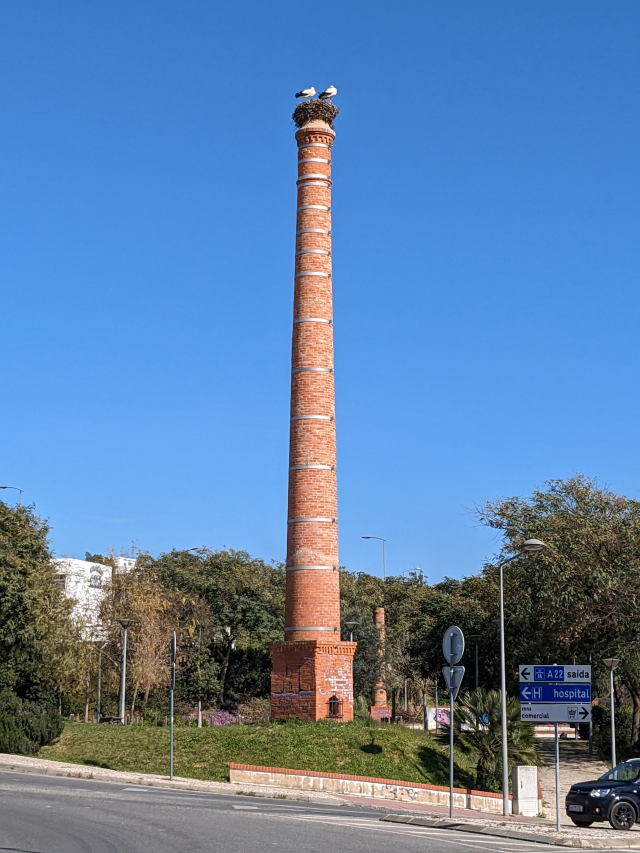
A couple of days later the sailmaker arrived with the new mainsail which Joe had paid for in advance. Incredibly, when we went to hoist it we found that the sailmaker had positioned the battens vertically, presuming there was in-mast reefing, instead of slab, and needless to say there was a row as he refused to change it unless Joe paid him extra, which he refused to do. As it turned out the old mainsail worked fine. Meanwhile launching time was approaching and the engine arrived. Significantly, I found all studs on the port rudder lower pivot loose and had to drill them out to bolt and secure it.
When we had almost given up hope on Friday evening the engine arrived in the dark and was lowered into position (we were launching Monday but the mechanic had been sick with Covid). We celebrated with mince piri piri washed down by wine. On Saturday it rained heavily but I repaired the inflatable’s outboard which was dripping petrol while the mechanic connected and got the 3 cylinder Volvo running sweetly for a few moments as there was no water cooling. On Monday just before launching he returned and installed a water separator.
It was still raining on Monday when we lifted and launched with about 10 cms clearance on either side of the boat on the slip.
The engine started, we moved out of the slip, then it cut out. Two things emerged quickly; the boat was very slow to turn with its long keels and the engine was continually getting air locked and cutting out. Fortunately the engine was easy to bleed, as the bleed screw was mounted on the filter on top of the engine and easily accessible.
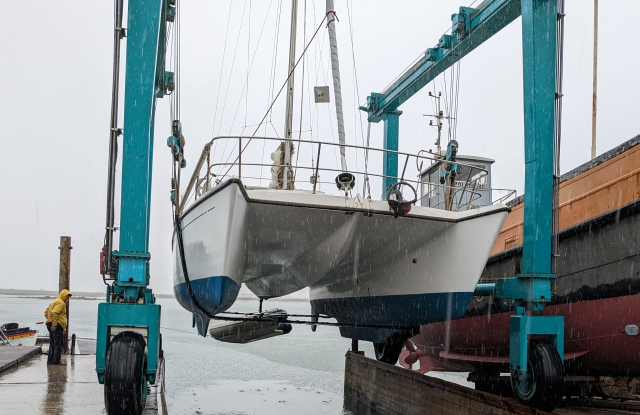
We followed a guide boat down the unmarked channel and on reaching navigation Buoy 23 the guide turned back. The plan discussed was to anchor inside the entrance, sort any issues out and leave the following day and as we approached the entrance Frank went forward and unclipped the anchor. However with a nice 2 knots ebb tide Joe decided to leave instead of anchoring. We surged through the breakers in the entrance and Joe hugged the lee shore in 4 metres depth with the breaking waves about 100 metres to leeward. Frank and I were very uncomfortable so I asked Joe who was steering to give us more sea room as the engine was continually stopping which he eventually did.
The boat was making about 4 knots GPS into an 8 knot wind as we motored towards Portimao but neither our log nor wind instruments were calibrated. There was an occasional clunk from the port hull but as neither Frank nor I had sailed a cat before we assumed this was normal when motoring into a swell. The autopilot was intermittent and I thought I had the fuel problem sorted by running a supply line from the water separator into a spare tank of fuel but it conked out after an hour and a half as the 25 l tank was empty - the return line had been filling the fuel tank which was now overflowing and leaving a trail of fuel behind. In the meantime, Joe went to sleep and we took turns steering. The boat was fairly stable in direction but no helm feel. It got dark and cold and we decided to go into Albufeira and tie up alongside a pontoon. As I had steered the boat into Albufeira I could understand why Joe likes anchoring as the boat with long keels does not manoeuvre well at low speeds with no prop wash over the rudders and the outdrive leg adjuster was needed to get any sort of a turn going at low speed. This adjuster of course was very stiff so it was necessary to plan well ahead. We berthed but when Joe went forward to tie the head line he shouted that the anchor was missing. In fact it was hanging down on about 3 metres of chain and probably had been since Faro. Although we checked the hull as best we could we found no damage other than Joe’s bed wet due to a leaking window. After an early breakfast we were on our way with intermittent but regular stuttering from our air locking engine.
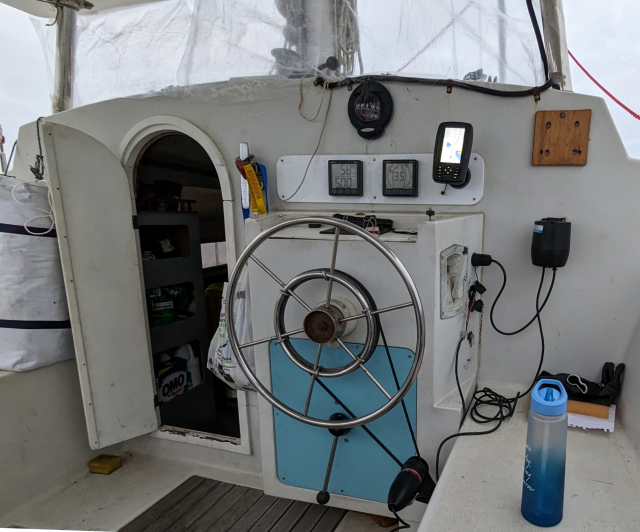
The course was set west for Alvor. Joe and Frank are very different characters and so far the trip had not appealed to my brother who was on holidays, but felt this was not one. However, he had never done a delivery trip before and had assumed that the boat would be much better prepared with less issues. The fact that he was also miserable with a cold did not help either. I think I had less illusions and was happy that the boat was now motoring at 5.8 knots at 2,000 RPM, anchor stowed and log calibrated after we left Albufeira.
We found and took the narrow entrance into Alvor wounding our way clockwise down the shallows before turning back towards the sea sheltered by sandbanks and letting the anchor go, intentionally this time! It is a lovely anchorage with some traditional boats with lots of food in the town which is only a couple of hundred metres from the anchorage with two slips to land on. To address the engine issue I borrowed some tanks and a siphon from David, an eccentric Englishman living on a trimaran. This allowed me to clean the fuel tank in which there was goo at the bottom, though not a huge amount. Later we invited David to dinner and discovered he had been an engineer with CERN but does not read newspapers or listen to the news. It was an interesting conversation as he seems a happy loner who has given up modern life and its attachments.
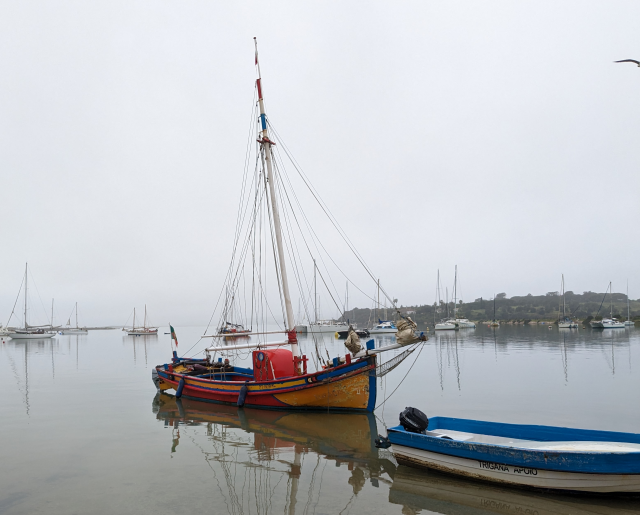
We got more diesel and left Alvor but unfortunately, the engine started air locking again. Then the autopilot stopped working again as we headed west for Cape St. Vincent. Despite our concerns we did not see any killer whales which were only attacking boats further south east near the entrance to the Straits of Gibraltar at the time. We rounded the Cape in the middle of the night and turned north towards Cascais. Frank did the first 3 hour watch, I did the 1-4 and Joe came on then. Frank did not like the night sail, which I think was his first, and it would take little for him to leave. However, we were still running on engine and I found if I left the bleed screw slightly open the engine ran for much longer but a small amount of diesel dripped onto the fan belt. I stripped the autopilot twice to no avail. Thinking about it made me realise that although the course setting LEDs showed in standby when you put it in operating mode they failed under load. Therefore, it was probably a supply issue which I eventually traced to a corroded negative supply wire – happiness.
We arrived in Cascais, which is a fine marina near the entrance to Lisbon, and were assigned an inside berth which I successfully manoeuvred into. Later, Frank drained the remainder of the diesel tank and we found that there was no compression fitting on the tank outlet pipe, just a rubber O ring. That was replaced with a compression ring and we hoped for the best. Meanwhile Joe lost his Visa card but it eventually turned up in the Marina Office the following day. Frank and I went ashore and had a lovely meal while Joe dined on board on chorizo and potatoes. All were happy.
Having filled up with diesel, I found that the bleed screw had stripped the threads in the fuel filter top and was now leaking, This was fixed by taking off the filter and putting a small bolt through with padding top and bottom. On thinking about the air lock issue I used a length of hose to bypass the new water filter. From then on the engine was faultless!! We left with slack winds but a big swell on the west coast with destination Póvoa do Varzim showing 5.8 knots, both indicated and GPS. We travelled north motor sailing through the night with visibility decreasing with the dawn until opposite Porto it was down to about 150m. A big ship blasted on its fog horn suddenly but it was only doing 2 knots. AIS was showing on our phones so at least we could track the biggies. Then sunshine broke through and we could see the ships and trawlers. Approaching Póvoa I called on the VHF to be told the port was closed due to the swell so we decided to continue to Baiona.
However, a bad weather forecast caused a rapid change of heart so we diverted into Viana do Castelo and tied up alongside a waiting pontoon on the river. The swell reached the berth so we doubled up mooring lines. I watched a strange small red lit buoy float down the river before realising it was the way the river fishing boats worked. They deploy a lighted float and stream their net across to the other bank where they light a white light and float down the current until opposite the harbour where they recover the net. Then they lash back up the river passing about 10 metres from out boat to recast.
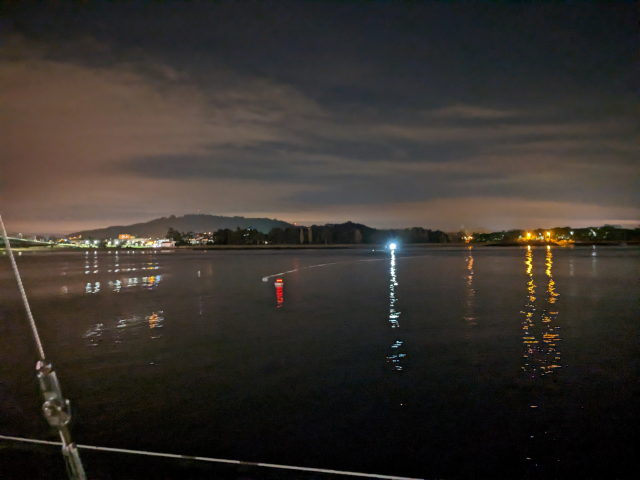
There are a number of boats at this, maybe 5, and it went on until 01.00 - when they went home we could sleep. We could not go into the marina as it was closed due to dredging and the weather forecast was not good for the following couple of days.
Movement of the boat was jerky and we were on a bucking bronco with breakers in the river for a couple of days with Joe having a bad toothache and Frank’s fibrillations at him. However, food and showers were good and we explored the town waiting for the weather to improve.

We left after three days with big swells outside, particularly inside the 30 metre contour, destination Camarinas about 18 nms north of Cape Finisterre. The shore shelves steeply to about 1,000 metres within 25 nms and some of the biggest swells in the world are found in this area. The sun was shining for us but no wind again.
I slowed the boat down as I did not fancy making Camarinas in the dark and bypassing Baiona on the way which I had hoped to visit again. During the night I checked my phone and came on watch an hour early but did not understand why until it clicked that we had passed into Spain which was an hour ahead of Portugal! This resulted in our making landfall and entering Rias Alta in the dark with a big swell. Although the entrance is 1 nm wide from the NW, it was blanked coming from the SW. In fact the most obvious thing was the street lighting from Muxia where the foreshore is called Playa del Morte. The entrance was hidden by the high bluff north of Muxia and as you approach the street lights of Muxia are very misleading. The plot showed that we should head directly towards the high ground on the northern shore and thankfully the entrance to the Ria De Camerinas opened as we neared the breakers. There was plenty of sea room to turn about and wait for the dawn if necessary.
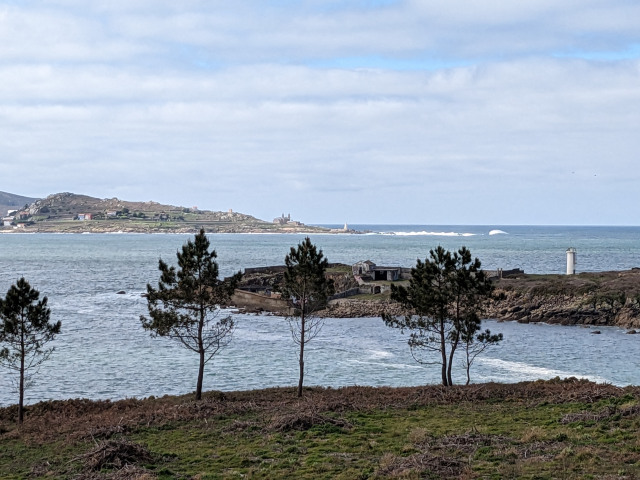
We rounded the breakwater and tied up on the hammerhead at 06.30 Spanish time. Camarinas is a nice Galician town with many unusually shaped and various coloured houses, some having lemon trees growing in their gardens. There was an old small centre with a warren of stone walled house but there were many unfinished houses of a more modern era to the north west. Intricate lace making is still a local custom and the restaurants only opened at 20.00. The marina is protected except in strong easterly winds when boats can get damaged, I was told. As it was the swell setting in from the west caused some surging. The marina pontoons themselves were in poor repair and some work was ongoing replacing the wood. The clubhouse, Club Nautica, was small, staff lovely but despite what the cruising guide stated, there was neither internet nor computers there. The two shower cubicles were the smallest I have ever come across with no windows. There was a motion activated light that only worked if you waved you hand above the cubicle, the dark caught me by surprise!
There are three good supermarkets and a number of restaurants which we checked out while awaiting a break in the weather for crossing Biscay. However lows were squirting across the path due to stationary highs over Greenland and the Azores and, despite waiting a week, there was no gap in which strong gales were not forecast for the crossing. Joe had little time for conversation other than about continuing and though I encouraged him to wait a month and cruise the Rias he wanted to get the boat back irrespectively. However neither Frank nor I were willing to chance the crossing in this 40 year old boat with a background of issues. As it was, we had given almost a month to bringing the boat home so we all booked tickets home. We had to get these printed and finally found the hidden public library where a lovely lady gave us an email address and printed them for us. So we said goodbye to Wild Goose and took a taxi for our flight home from Santiago.
Later, Joe went back down two weeks later and brought Wild Goose home but that is another’s story for another time. And no, Frank and Joe did not gel.